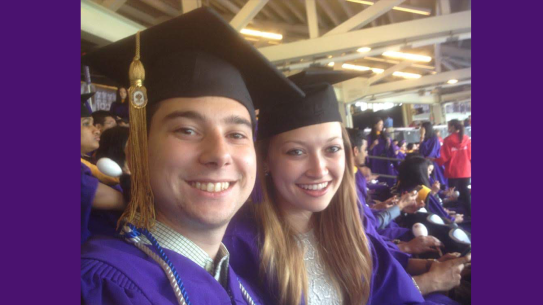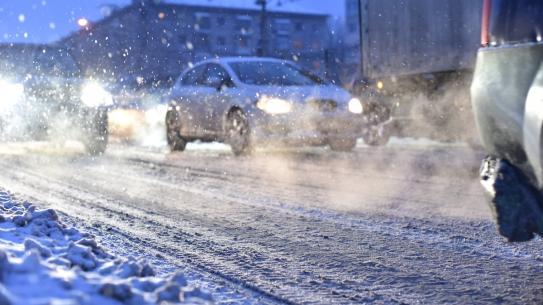NYU Tandon welcomes new faculty members pushing the boundaries of robotics and AI

Assistant Professors Pavel Izmailov (left) and Benjamin Rivière
Robotics and AI are now touching our everyday lives, revolutionizing how businesses operate, and making previously unimagined advances in sectors from healthcare to transportation a reality. With our Center for Robotics and Embodied Intelligence, Tandon is evolving into a major hub of research in the field, and our new faculty members are right at the forefront.
New Faculty:
Assistant Professor Pavel Izmailov
NYU Tandon Department of Computer Science and Engineering and NYU Courant Department of Computer Science
Pavel Izmailov points out that there was a time, not that long ago, when computers could not discern the difference between dogs and cats. We’ve come a long way since then, with AI now being leveraged to help medical practitioners diagnose disease, financial professionals detect fraud, robots successfully navigate difficult terrain, and much more.
Izmailov, who has worked at such major companies as OpenAI and Anthropic, has made significant contributions to those increasingly sophisticated systems.
While at OpenAI, Izmailov, helped develop OpenAI o1, an innovative large language model (LLM) trained with reinforcement learning to perform complex reasoning. Able to produce a long internal chain of thought before responding to a user’s query, the model placed among the top 500 students in the U.S. in a qualifier for the highly competitive American Invitational Mathematics Examination and exceeded human doctoral-level accuracy on a benchmark of physics, biology, and chemistry problems. At Anthropic, he has been involved in the development of increasingly powerful versions of the popular AI assistant Claude, including Claude 4, which has proven incredibly adept at completing coding tasks.
Izmailov, whose work on Bayesian model selection was recognized with an Outstanding Paper Award at the 2022 International Conference on Machine Learning, was part of OpenAI’s superalignment team, a cadre of researchers whose aim was to make artificial general intelligence (AGI) that aligns with human values and follows human intent.
In that capacity, Izmailov explored what might happen when the superhuman models of the future behave in ways too complex for humans to reliably evaluate. This is a serious issue because widely used alignment techniques, such as reinforcement learning from human feedback, rely on a developer’s ability to determine whether a model has followed instructions accurately or generated safe outputs. That work, covered extensively in media outlets such as Wired and MIT Technology Review, was complicated by the fact that superhuman models do not yet exist; the solution was to look at how the older model GPT-2 fared in supervising the more sophisticated GPT-4 — an experiment that showed mixed but promising results.
While acknowledging that unaligned AGI could pose risks to humanity, Izmailov disavows the notion that a malicious, entity like HAL, the rogue computer in the 1968 film 2001: A Space Odyssey, is in our immediate future. “Achieving AGI is going to be harder than many people think,” he predicts. “What we will have are models that can do increasingly interesting things.”
Assistant Professor Benjamin Rivière
NYU Tandon Department of Mechanical and Aerospace Engineering and NYU Courant Department of Computer Science
Science Robotics, a journal published by the American Association for the Advancement of Science, is dedicated to providing a high-level forum for the latest technological advances and issues surrounding robotics. Having an article accepted to the peer-reviewed publication is a noteworthy achievement for any young researcher.
Benjamin Rivière, who will work within Tandon’s new Center for Robotics and Embodied Intelligence, earned that honor in 2024 with his paper “Online tree-based planning for active spacecraft fault estimation and collision avoidance.”
Making it onto the cover is even rarer, but just a few months later, another of his papers, “Monte Carlo tree search with spectral expansion for planning with dynamical systems,” did just that.
Rivière explains that in order for autonomous robots to operate in complex environments, they need to be able to reason quickly and effectively about their motions. Monte Carlo Tree Search (MCTS), which imitates a real-time “thinking” process by trading off exploration and exploitation, could be a viable solution if it were not for the fact that it cannot be directly applied to continuous systems to generate physical motions for robots. Rivière and his co-authors thus developed Spectral Expansion Tree Search, a method that enables MCTS-based planning by computing an efficient discrete representation of the physical world. The framework allowed various robots to autonomously plan the best motions to navigate uncertain environments, avoid moving obstacles, traverse windy gusts, and support a human driver in shared control tasks. The algorithm can also be combined with machine learning models to marry offline and online computation for robotics, analogous to the famous AlphaZero algorithm for board games.
Among the complex environments that most interest Rivière is space — where an autonomous vehicle might be deployed in active space debris removal and must get from point A to point B without being struck by an asteroid. Just as cities have trash collectors, Riviere envisions a future in which a spacecraft or team of spacecraft coordinate to manipulate and deorbit dangerous space debris to create a sustainable space ecosystem.
At the Center for Robotics and Embodied Intelligence, his eponymous lab will simulate the dynamics of space, with the same software and hardware as a spacecraft. In addition to his research, he’ll be teaching a graduate-level course, “Planning, Learning, and Control for Autonomous Space Robots,” which will touch upon existing applications like precision rocket landings and Martian rover path planning, and proposed future missions like distributed apertures of spacecraft swarms and complex locomotion for planetary exploration.
Rivière, who earned his Ph.D. at California Institute of Technology (CalTech) in 2024 and completed his postdoctoral studies there this year, is excited to begin exploring Brooklyn — and to continue advancing space exploration through robotics.




